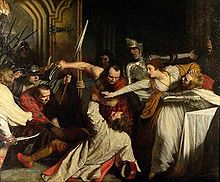David Rizzio, sometimes written as David Riccio or David Rizzo (c. 1533 – 9 March 1566) was an Italian courtier, born close to Turin, a descendant of the ancient and noble family still living in Piedmont Riccio Counts de San Paolo et Solbrito, who rose to become the private secretary of Mary, Queen of Scots. Mary's husband, Henry Stuart, Lord Darnley, is said to have been jealous of their friendship, because of rumours that he had made Mary pregnant, and joined in a conspiracy of Protestant nobles, led by Patrick Ruthven, 3rd Lord Ruthven, to murder him. The murder was the catalyst for the downfall of Darnley and had serious consequences for Mary's subsequent career.[1]
Career
Rizzio, (whose name appears in Italian record as David Riccio di Pancalieri in Piemonte), went first from Turin to the Court of the Duke of Savoy, then at Nice. However, meeting no encouragement there, found means to get himself admitted into the train of the Count de Moretto in 1561, who was upon the point of setting out an embassy to Scotland.[2] The Court in Scotland had no employment for Rizzio, and dismissed him. He ingratiated himself with the Queen's musicians, whom she had brought with her from France. James Melville, a personal friend of Rizzio, said that "Her Majesty had three valets in her chamber, who sung three parts, and wanted a bass to sing the fourth part". Thus, he was drawn into her court (Hawkins, 1778).
He was considered a good musician, and an excellent singer, which first brought him to the attention of the cosmopolitan young Queen. Towards the end of 1564, having grown wealthy under her patronage, he became the Queen's secretary for relations with France, after the previous occupant of the post retired there. This post attracted a quarterly salary of £20.[3] Ambitious, seeing himself as all but a Secretary of State, a Catholic, and a foreigner to boot, Rizzio had too much of the Queen's ear, it was felt. Rumours became rife that Mary was having an adulterous affair with Rizzio.
[edit] Murder
| This section needs additional citations for verification. Please help improve this article by adding reliable references. Unsourced material may be challenged and removed. (April 2009) |

Jealousy precipitated his murder in the Queen's presence, in her supper chamber ("a cabinet abowte xii footes square, in the same a little low reposinge bedde, and a table"[4]) in the Palace of Holyroodhouse after the royal guards were quickly overpowered and the palace was turned over to the control of the rebels. The Queen was seven months pregnant (with James VI) at the time. Having burst into the Queen's private dining room, the rebels, led by Patrick Ruthven, 3rd Lord Ruthven, demanded Rizzio be handed over. The Queen refused. Rizzio then hid behind Mary, who having tried desperately to protect him, was herself threatened at gun point. The hysterical screams of the Queen and Rizzio travelled out of the palace and alerted the people of Edinburgh.[citation needed] Several hundred local men poured out of the local taverns and ran to Holyrood with makeshift weapons, but with a gun held at her side, the Queen was forced to go to the window and dismiss them.[citation needed]
After this violent struggle, Rizzio was stabbed an slashed 56 times,[5] before being thrown down the main staircase and stripped of his jewels and fine clothes. He was buried within two hours in the cemetery of Holyrood. Buchanan and Daniel[6] state that shortly after his body was removed by the Queen's orders, and deposited in the sepulchre of the Kings of Scotland; a measure most impolitic, as it strengthened the previous reports of her familiarity with him (Ruthen 1815). Rumours were thrown around as to why this happened to Rizzio - most claim Darnley was jealous
[edit] Aftermath
Rizzio's murder was only one incident in the larger campaign by Scottish nobles and Queen Elizabeth I, to destabilise the Scottish Queen, whose popularity and liberal policies threatened their preferred status quo in the British Isles. Elizabeth I is said to have funded the murder, and certainly provided sanctuary for Rizzio's killers[citation needed]. The fact that he was murdered in Mary's presence, when she was heavily pregnant, made it a particularly shocking event. The written account of the events by the Queen was naturally anxious and rambling, and is thought to have been a major factor in her nervous breakdown the following year[citation needed].
It was hoped by the Scottish nobles and the English government that the result of his death would be the death of the Queen and/or her unborn child, allowing the factions to control power in Scotland[citation needed]. However, Mary surprised her enemies by charming the rebel guard, before swinging out of her palace windows on knotted bedsheets and fleeing her capital on horseback in the middle of the night. She returned to Edinburgh triumphant within the week, at the head of 8,000 troops, driving the rebels over the border to seek refuge from prosecution, and honouring her murdered friend with a lavish funeral.
Rizzio's brother, Joseph, arrived in Scotland with Michel de Castelnau and was appointed secretary in David's place by 25 April 1566. Joseph and an Italian colleague, Joseph Lutyni, had some trouble over coins taken from the queen's purse, and in April 1567 he was accused and acquitted with Bothwell of Darnley's murder.[7]
David Rizzio's career was remembered and referred to by Henry IV of France. Mocking the pretension of James VI of Scotland to be the "Scottish Solomon", he remarked that "he hoped he was not David the fiddler's son", alluding to the possibility that Rizzio, not Darnley, fathered King James.
Rizzio is buried at Canongate Kirkyard, Edinburgh.
